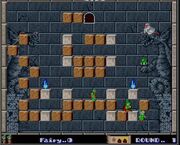- For other uses, see Solomon's Key (disambiguation).
Solomon's Key (ソロモンの鍵 Soromon no Kagi) is a puzzle game developed by Tecmo in 1986 for arcade release on custom hardware based on the Z80 chipset. It is better known as a 1987 port to the Commodore 64 and the Nintendo Entertainment System, although it also appeared on many other game systems of the time, like the Sega Master System in 1988 and the Famicom Disk System, released in Japan on January 25, 1991.
Overview[ | ]
Solomon's Key is generally recognized as one of the most difficult games to appear on the NES. The player must overcome unlimited enemy spawning, challenging level designs, a countdown timer, Dana's fragility, and limited ways to dispatch enemies. In addition, it's easy for players to unintentionally make levels impossible to clear while playing them. There is no saving, so if you lose all of your lives at level 49, you get to start all over.
Solomon's Key has many hidden items and secret levels that are hard to find which enhances the reward for playing. The ending slightly changes depending on which secret levels, if any, the player finds and completes.
Gameplay[ | ]

Arcade version of Solomon's Key
The main character, Dana is sent to retrieve "Solomon's Key" to restore the world to light from demons that were accidentally released. The object of the game is to advance through the 50 rooms of "Constellation Space" by acquiring a key to the door that leads to the next room before a timer runs out. The game incorporates elements of the platform shooter genre. Dana can run, jump, create or destroy orange blocks adjacent to him as well as create fireballs to destroy demons. The orange blocks can also be destroyed by hitting them with your head twice. Along the way Dana can acquire items to upgrade his firepower and extra lives as well as items that award bonus points and unlock hidden rooms. With certain items, Dana must make, then break blocks (sometimes in a certain manner) to make these appear.
Levels[ | ]
There are 64 levels in total with 15 being secrets. The main levels are divided into groups of 4 with one group for each Zodiac constellation. The final level is called Solomon's room. Each constellation has a secret bonus room which can only be accessed by finding a seal for the constellation in the last room of the group. The other three levels are Page of Time, The Page of Space, and the Princess Room which occur only if the player has acquired the hidden Seals of Solomon.
- 1-4 Aries
- 5-8 Taurus
- 9-12 Gemini
- 13-16 Cancer
- 17-20 Leo
- 21-24 Virgo
- 25-28 Libra
- 29-32 Scorpio
- 33-36 Sagittarius
- 37-40 Capricorn
- 41-44 Aquarius
- 45-48 Pisces
Notes[ | ]
At the Game Over Screen a "GDV", or Game Deviation Value score also appears. The score uses a weighted composite of several factors (like levels completed, items found, time and points) which gives the player a good idea of how well the last game was played. The higher the GDV the better the game.
Enemies[ | ]
Ports and sequels[ | ]
In 1988, a port of Solomon's Key was made for the Sega Master System in Japan.
A sequel for the Nintendo Game Boy system entitled Solomon's Club was released in 1991.
In 1993, a prequel was released for the NES named Fire 'N Ice in North America (called Solomon's Key 2 elsewhere).
The 1999 Game Boy Color release Monster Rancher Explorer (called simply "Solomon" in Japan) by Tecmo is an updated port of Solomon's Key.
The arcade version was included in Tecmo Classic Arcade in 2005.
The NES version of the game was released for the Wii's Virtual Console on November 19, 2006 in North America.[1] and on December 15, 2006 in the PAL regions.[2]
The arcade version came out on the Virtual Console in Japan on August 18, 2009, in the PAL regions on September 11, 2009 and in North America on November 30, 2009.
References[ | ]
- ↑ Parish, Jeremy (2006-10-31). Wii Virtual Console Lineup Unveiled. 1UP.com. Retrieved on 2006-11-01
- ↑ Euro VC updates for tomorrow.
External links[ | ]
- Solomon's Key instruction manual
- Solomon's Key at Museum of the Game
- Solomon's Key wiki guide at StrategyWiki
- Solomon's Key at GameFAQs
- Fabia Sanna's information site on Solomon's Key
- PC Remake from Zikitrake Soft
- Solomon's Key at MobyGames
- Solomon's Key at World of Spectrum
